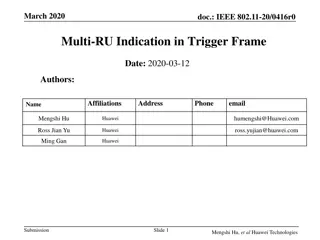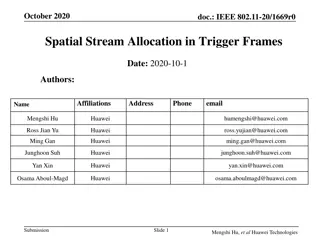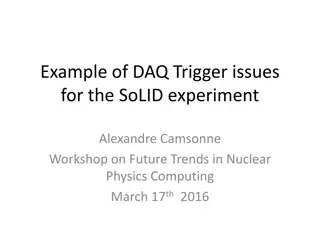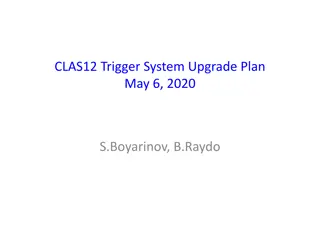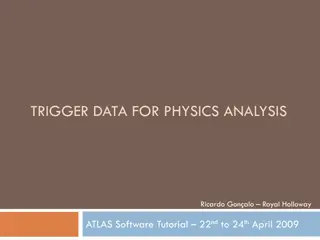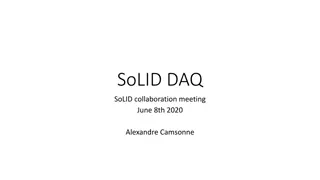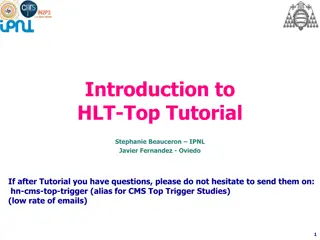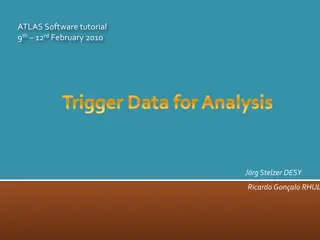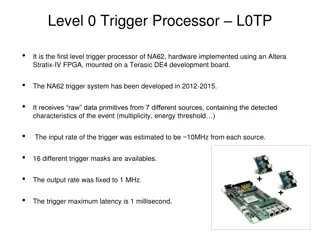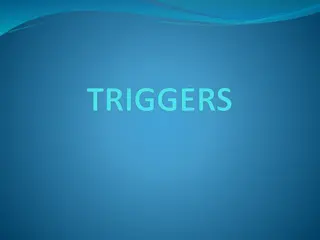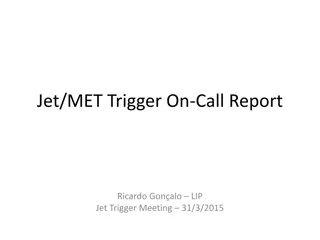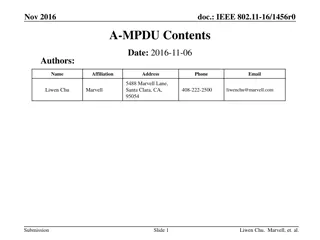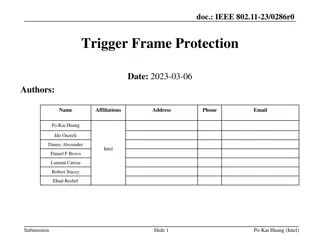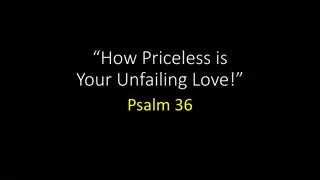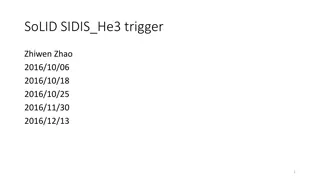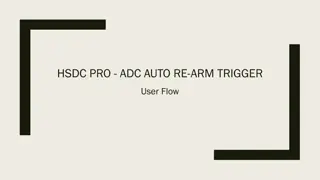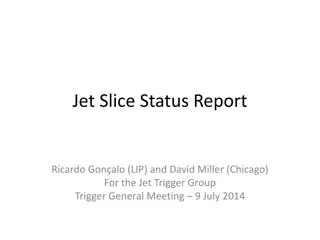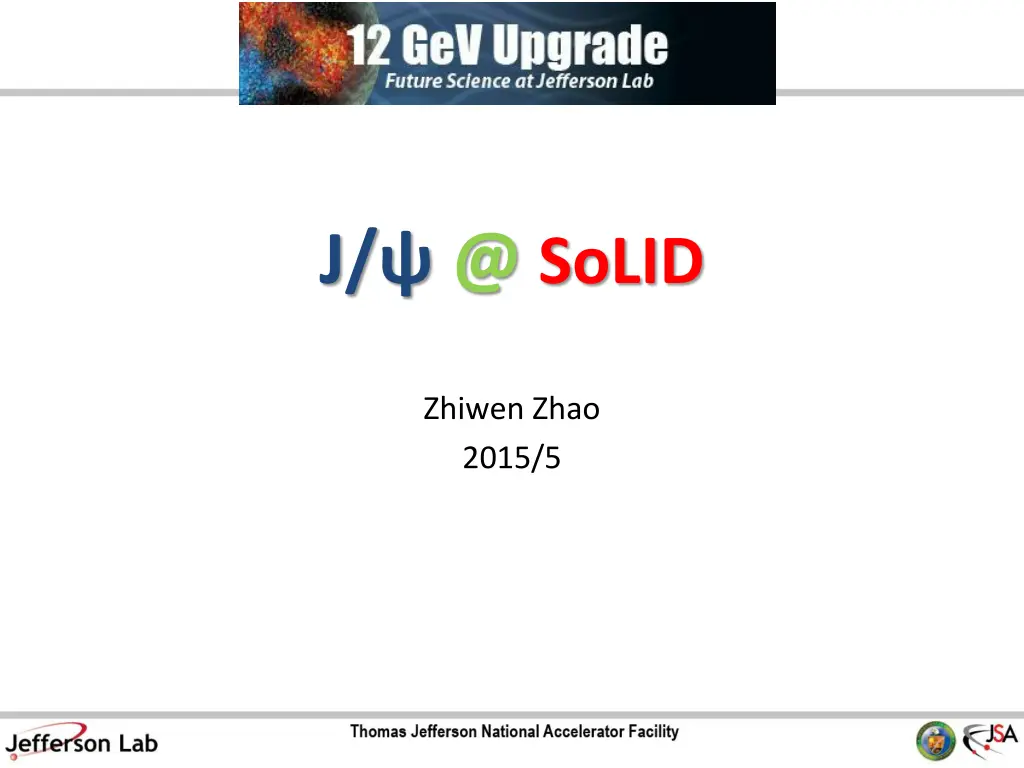
Electro vs. Photo Production Insights
"Explore the differences between electroproduction and photoproduction, including energy resolution, background statistics, trigger mechanisms, acceptance criteria, and possible trigger strategies. Discover how virtual photon energy and recoil particle detection play vital roles in determining production outcomes."
Download Presentation

Please find below an Image/Link to download the presentation.
The content on the website is provided AS IS for your information and personal use only. It may not be sold, licensed, or shared on other websites without obtaining consent from the author. If you encounter any issues during the download, it is possible that the publisher has removed the file from their server.
You are allowed to download the files provided on this website for personal or commercial use, subject to the condition that they are used lawfully. All files are the property of their respective owners.
The content on the website is provided AS IS for your information and personal use only. It may not be sold, licensed, or shared on other websites without obtaining consent from the author.
E N D
Presentation Transcript
J/ @ SoLID Zhiwen Zhao 2015/5
PID 2 + + * / N N J e p e p J/ (e- e+) p p J/ (e- e+) electroproduction detect decay e- e+ pair and scattered e- photoproduction detect decay e- e+ pair and recoil p Scattered e- and Decay e-/e+: EC + SPD + CC @ forward angle EC + SPD @ large angle Recoil p: 100 ps TOF(MRPC): 4 separation p/K up to 4.5 GeV and p/pi up to 5GeV @ forward angle 150 ps TOF(SPD): 4 separation p/K up to 2GeV and p/pi up to 2.5 GeV @ large angle (new)
TOF 3 Recoil p: 100 ps TOF(MRPC): 4 separation p/K up to 4.5 GeV and p/pi up to 5GeV @ forward angle 150 ps TOF(Scint): 4 separation p/K up to 2 GeV p/pi up to 2.5GeV @ large angle FA LA
Electroproduction vs. Photoproduction 4 production Energy resolution W reach Background Statistics Electro- better lower less less Photo- worse higher more more Electroproduction o virtual photon energy solely determined by detection of scattered e-, like a tagged virtual photon beam o non-zero Q2 gives lower W reach o More final particle detection can have less background Photoproduction o photon energy derived from detection of recoil p, decay e-, decay e+ o more statistics Trigger on decay e- and decay e+ to include both channels 4
Acceptance (Electroproduction) 5 Require all 4 particles Require decay pair only Possible Trigger 1 (flat): electron trigger by EC with 4GeV threshold at forward angle and 2GeV at large angle to detect decay pair (stars shows trigger energy) This allows both electroproduction and photoproduction in data collection Acceptance for photoproduction needs further study Lower energy electron detection needs further study 5
Possible Trigger 1 (flat) 6 Done in the way similar to the trigger study for SIDIS_He3 Single electron trigger by flat EC > 4GeV at FA and flat EC>2GeV at LA Histograms showing rate before and after trigger cut Using SIDIS_He3 EC trigger response for now, but luminosity (1e37/cm2/s) are similar for both and background has no big effect on EC trigger for this level of luminosity) LAEC FAEC
Possible Trigger 1 (radial) 7 MRPC+FASPD can reduce trigger rate from pi0 photon by factor 20 LASPD can reduce trigger rate from pi0 photon by factor 5 LGCC can reduce photon background by 40 and hadron backgroud by 40(rand. Coin.) and 55 (corr. Coin.) Single electron trigger including both FA and LA is about 1.54MHz Coincidence of two electron trigger within 30ns time window is 1.54e6*1.54e6*30e-9 = 71kHz, which is below 100kHz SIDIS Setup limit Single electron trigger FA (4GeV flat) 335kHz =328+4+4/40+181/20/40+(18+20+24)/40+(18+20+24)/55 =328(e) + 4(e( 0) front) + 0.1(e( 0) back) +0.23( ( 0)) + 1.6(hadron rand. coin.) + 1.1(hadron corr. coin.) LA (2GeV flat) 1200kHz = 33+27+1390/5+(247+376+239) = 33(eDIS) + 27(e( 0))+ 270( ( 0))+862(hadron)
Acceptance comparison 8 TCS/BH (photo + quasi-photoproduction) Jpsi (Electroproduction) Require proton and decay pair Require decay pair only Possible Trigger 2 (radial): electron trigger by FAEC with 4GeV (r=105-115cm), 3GeV (r=115-145cm) and 2GeV (r=145-235cm), by LAEC with 3GeV (r=80-100cm) and 2GeV (r=100-140cm) (stars shows trigger energy) This allows both TCS and JPsi electroproduction and photoproduction in data collection 8
Possible Trigger 2 (radial) 9 Done in the way similar to the trigger study for SIDIS_He3 Single electron trigger by EC radial Histograms showing rate before and after trigger cut Using SIDIS_He3 EC trigger response for now, but luminosity (1e37/cm2/s) are similar for both and background has no big effect on EC trigger for this level of luminosity) LAEC FAEC
Possible Trigger 2 (radial) 10 MRPC+FASPD can reduce trigger rate from pi0 photon by factor 20 LASPD can reduce trigger rate from pi0 photon by factor 5 LGCC can reduce photon background by 40 and hadron backgroud by 40(rand. Coin.) and 55 (corr. Coin.) Single electron trigger including both FA and LA is about 1.13MHz Coincidence of two electron trigger within 30ns time window is 1.13e6*1.13e6*30e-9 = 40kHz, which is below 100kHz SIDIS Setup limit Electron trigger FA (radial) 682kHz =430+128+128/40+3570/20/40+(745+1080+868)/40+(745+1080+868)/55 = 430(e) + 128(e( 0) front) + 3(e( 0) back) +4.5( ( 0)) + 67(hadron rand. coin.) + 49(hadron corr. coin.) LA (radial) 446kHz = 23+11+581/5+(85+131+80) = 23(eDIS) + 11(e( 0))+ 116( ( 0))+296(hadron)
Summary 11 LASPD(TOF) will help proton detection for JPsi By triggering on electron decay pair, JPsi can do both electro and photoproduction Radial dependent trigger (40kHz< 100kHz limit) is not only help Jpsi reducing trigger rate, but also allow TCS running in parallel TCS physics is dominant by BH process which in turn will be helpful for Jpsi normlization
SoLID JPsi Trigger 12 Trigger on decay electron and positron Allow both electroproduction and photoproduction in data EC has radial dependent trigger threshold from 4 2GeV (stars) LGCC, MRPC, SPD help reject other hadrons and photons Same trigger works for Jpsi and TCS as run group Jpsi (Electroproduction) Require decay pair only Study was done in the way similar to PVDIS and SIDIS trigger rate Using SIDIS_He3 EC trigger response for now, luminosity (1e37/cm2/s) is similar for both and background has no big effect on EC trigger for this level of luminosity) Single electron trigger including both FA (682kHz) and LA(446kHz) is about 1.13MHz Coincidence of two electron trigger within 30ns time window is 1.13e6*1.13e6*30e-9 = 40kHz, which is below 100kHz SIDIS Setup limit 12
Just ideas, but changes are definitely needed Downstream collar enlarge by by 15cm in z (engineering need for support) Endcap move 15cm downstream and enlarge 30cm (SIDIS setup needs room) Endcap nose back reduce 5cm in r (EC hexagon module needs room) 6cm gap between downstream collar and endcap (let cable out, more cable out at back needed) Main impact, PVDIS EC large angle performance Need design with full 3D model and satisfy both physics and engineering requirement needed by all subsystems to fix their design, must be a coherent effort More realistic design now, More saving of man power, effort, cost, maybe even physics 13 new current
backup 14
Comments: SoLID Director Review 15 During review How does SoLID JPsi comparing to other JPsi programs? The committee seems like our answer in the next slide, so they didn t mention it in the final review conclusion
J/ @J Lab Comparison 16 Eugene Chudakov, JPsi workshop at Temple in 2012 The estimation assumed luminosity ~1e37/cm2/s similar to the approved SoLID experiment. The estimation assumed J/ cross section 0.01nb at 8.4<E< 9GeV. The cross section could rise to 0.1nb at 9<E<12GeV, but it won t change acceptance much, so the comparison will be similar. In Hall D case, for photon intensity of 108, the production would change to 3/day. SoLID has higher photon intensity than HallD
Comments: SoLID Director Review 17 After review, in the final review conclusion The signal and background trigger rates should be simulated for the J/ measurements. (try to answer this time) Bin migration effects should be simulated for the measurements of the sharply rising J/ production cross section near threshold. (need to think about it, will try to answer in near future)
Projection of Total Crossection 18 Need to work on Bin migration effects Lumi 1.2e37/cm2/s 11GeV 3uA e- on 15cm LH2 50 Days With ~ 0.02 GeV energy resolution for E and small binning to study the threshold behavior of cross section
Decay 19 Look into decay model What we can learn from decay of J/ provide about its production?
20 Electron trigger FAEC (2GeV flat) 1115kHz =509+315+315/40+7300/20/40+6300/40+6300/55 =509(e) + 315(e( 0) front) + 8(e( 0) back) +9( ( 0)) + 159(hadron rand. coin.) + 115(hadron corr. coin.) LAEC (2GeV flat) 1200kHz = 33+27+1390/5+(247+376+239) = 33(eDIS) + 27(e( 0))+ 270( ( 0))+862(hadron)




